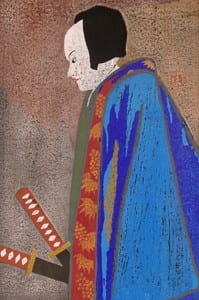In the The Frank and Toshie Mosher Gallery of Japanese Art
April 25, 2014 through April 19, 2015

The last quarter of the 19th century brought profound changes in Japan as it transformed from a feudal society into a modern nation. Japanese artists went through equally fundamental changes as new theories were introduced from the other side of the world through books, magazines and increased travel by both Japanese and Westerners.
In the field of woodblock prints, the traditional ukiyo-e(pictures of the floating world) of the Edo and Meiji periods fell by the wayside, in favor of reinvigorated forms of printmaking as a means of artistic expression. Known as sosaku hanga (creative prints), artists in this group attempted to bridge “fine art,” a newly introduced Western concept, and “craft.” Breaking away from the so-called ukiyo-equartet system involving artists, carvers, printers and publishers, the artists in this movement designed, cut and printed their own images. Artists in the sosaku hangamovement found great inspiration from magazines that introduced the theories and styles of movements such as Impressionism, Art Nouveau and Avant-garde. On the other side of the spectrum, the shin hanga (new prints) movement endeavored to revitalize traditionalukiyo-e by maintaining the quartet system.
Watanabe Shozaburo (1885-1962), the driving force behind shin hanga, published prints by the artists he represented utilizing traditionally trained carvers and printers. Guided by this influential advocate, shin hanga artists embraced the past yet modernized their images to appeal to the Western audience and compete against the more Western-oriented sosaku hanga.
Closely tracking with the significant developments in Japanese political and social spheres of the early 20th century, the exhibition presents examples of shin hanga and sosaku hanga side-by-side in order to bring their shared aspects into focus for visitors, as well as their distinguishing characteristics. Major artists of the shin and sosaku hangamovements, including Kawase Hasui, Hiroshi Yoshida, Ito Shinsui, Kiyoshi Saito and Munakata Shiko, are included in two complete six-month rotations.